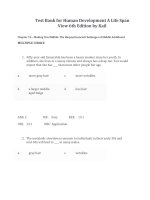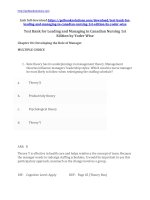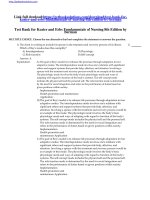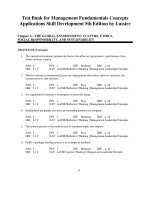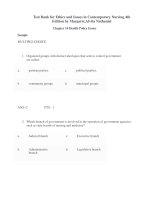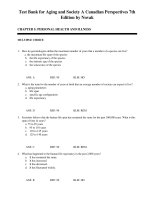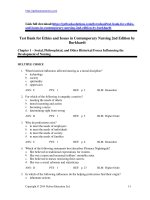Download test bank for ethics and issues in contemporary nursing 4th edition by margaretalvita nathaniel
Bạn đang xem bản rút gọn của tài liệu. Xem và tải ngay bản đầy đủ của tài liệu tại đây (372.53 KB, 9 trang )
Test Bank for Ethics and Issues in Contemporary Nursing 4th
Edition by Margaret,Alvita Nathaniel
Chapter 14 Health Policy Issues
Sample
MULTIPLE CHOICE
1. Organized groups with distinct ideologies that seek to control government
are called:
a.
partisan parties.
c.
political parties.
b.
community groups.
d.
municipal groups.
ANS: C
PTS: 1
2. Which branch of government is involved in the operation of government agencies,
such as state boards of nursing and medicine?
a.
Judicial branch
c.
Executive branch
b.
Administrative
branch
d.
Legislative branch
ANS: B
PTS: 1
3. Nurses function in a variety of roles, and responsible political involvement is
an important function of each of these roles. These roles can include:
a.
knowledgeable consumers of health care.
b.
citizens.
c.
professionals whose practice is regulated by the
government.
d.
advocates for patients.
e.
all of the above
f.
a, c, and d
ANS: E
PTS: 1
4. When political parties take opposing positions on an issue, the different
opinions and subsequent decisions are said to be:
a.
invalid.
c.
political.
b.
partisan.
d.
unethical.
ANS: B
PTS: 1
5. Which of the following is true?
a.
Moral issues and political issues are very different.
b.
Knowledge of moral principles will guide policy
makers to the one correct policy.
c.
A moral issue can become “political” in a number of
ways.
d.
Judicial precedents are rarely considered when policy is
formulated.
ANS: C
PTS: 1
6. Which of the following is both a moral and political issue?
a.
Abortion
b.
Stem cell research
c.
Physician-assisted suicide
d.
All but b above
e.
All of the above
ANS: E
PTS: 1
7. A nurse becomes concerned because her facility consistently requires mandatory
overtime, up to 40 additional hours per week. The nurse brings the issue to the
attention of her professional organization, and together they approach their
legislator. These acts can be considered which of the following?
a.
Policy formulation
c.
Policy evaluation
b.
Policy
implementation
d.
Policy modification
ANS: A
PTS: 1
8. The nurses’ organization decides to work toward legislation that would limit
mandatory overtime in the workplace. They mobilize large numbers of nurses and
community volunteers to write letters and make personal contact with legislators.
This form of political activism is known as which of the following?
a.
En masse lobbying
c.
Grassroots lobbying
b.
Partisan lobbying
d.
Political lobbying
ANS: C
PTS: 1
9. A nursing professor is actively involved in lobbying for health policy issues.
The professor tells the class that these activities are moral duties. What is the
best explanation for this statement?
a.
The nursing professor likely learned the sense of duty
from her upbringing.
b.
The nursing professor has a deontological ethical
perspective.
c.
The ANA and ICN codes of ethics for nurses direct the
nurse to promote efforts to meet the health needs of
society.
d.
The nursing professor is attempting to influence the
students to become politically active.
ANS: C
PTS: 1
10. Which of the following is a health policy issue of concern to the profession
of nursing?
a.
Abortion
b.
Third-party reimbursement
c.
Air pollution control
d.
Gun control
e.
All of the above
f.
a, b, and c above
ANS: E
PTS: 1
11. Which of the following is a description of the most effective type of letter sent to
a policy maker in a lobbying campaign?
a.
A long emotional plea that is very thorough
and explanatory and includes many examples
b.
A form letter with a handwritten salutation and signature
c.
A concise handwritten letter written in your own
words, using your own thoughts and logic
d.
A letter that includes a list of all topics of interest to
nurses in your area
ANS: C
PTS: 1
12. Issues that are created, affected, or regulated by any of the government branches
are:
a.
political issues
c.
health policy issues
b.
partisan issues
d.
regulatory issues
ANS: A
PTS: 1
13. A politically active nurse lobbies legislators in her state to enact universal health
insurance legislation. Which ethical principle most likely serves as the
foundation for this political activity?
a.
Justice
c.
Nonmaleficence
b.
Fidelity
d.
Autonomy
ANS: A
PTS: 1
MULTIPLE RESPONSE
1. Which of the following statements regarding allocative policies are true? Select all
that apply.
a.
Allocative policies are an area in which we see
distributive justice in practice.
b.
Allocative policies are essentially economic in nature.
c.
Allocative policies determine what programs are funded.
d.
Medicare and Medicaid are the most well-known
allocative health policies.
e.
Allocative policies are those designed to direct the
actions, behaviors, and decisions of individuals or groups.
ANS: A, B, C, D
PTS: 1
2. The process of health policy includes which of the following phases? Select all
that apply.
a.
Policy solutions
b.
Policy implementation
c.
Policy formulation
d.
Policy problems
e.
Policy modification
ANS: B, C, E
PTS: 1
